8 results
7 - Archetypes and ‘Platonic’ Mysticism
-
- Book:
- Exploring Religious Pluralism
- Published online:
- 14 March 2024
- Print publication:
- 21 March 2024, pp 104-117
-
- Chapter
- Export citation
7 - The Quest for the Historical Buddha
-
- Book:
- The Buddha
- Published online:
- 09 November 2023
- Print publication:
- 30 November 2023, pp 247-282
-
- Chapter
- Export citation
5 - Classical (Local) Hardy Inequalities
-
- Book:
- Fractional Sobolev Spaces and Inequalities
- Published online:
- 06 October 2022
- Print publication:
- 13 October 2022, pp 75-103
-
- Chapter
- Export citation
6 - Fractional Analogues
-
- Book:
- Fractional Sobolev Spaces and Inequalities
- Published online:
- 06 October 2022
- Print publication:
- 13 October 2022, pp 103-120
-
- Chapter
- Export citation

Fractional Sobolev Spaces and Inequalities
-
- Published online:
- 06 October 2022
- Print publication:
- 13 October 2022
Chapter 6 - Cruel Intimacies: Christina Rossetti and Thomas Hardy
-
- Book:
- Conversing in Verse
- Published online:
- 21 July 2022
- Print publication:
- 04 August 2022, pp 136-154
-
- Chapter
- Export citation
Chapter 4 - Darwin’s Little Ironies
-
- Book:
- Mimicry and Display in Victorian Literary Culture
- Published online:
- 16 May 2020
- Print publication:
- 11 June 2020, pp 116-148
-
- Chapter
- Export citation
Chapter 4 - A Wrinkle in Time
-
- Book:
- Aging, Duration, and the English Novel
- Published online:
- 14 November 2019
- Print publication:
- 05 December 2019, pp 90-113
-
- Chapter
- Export citation


